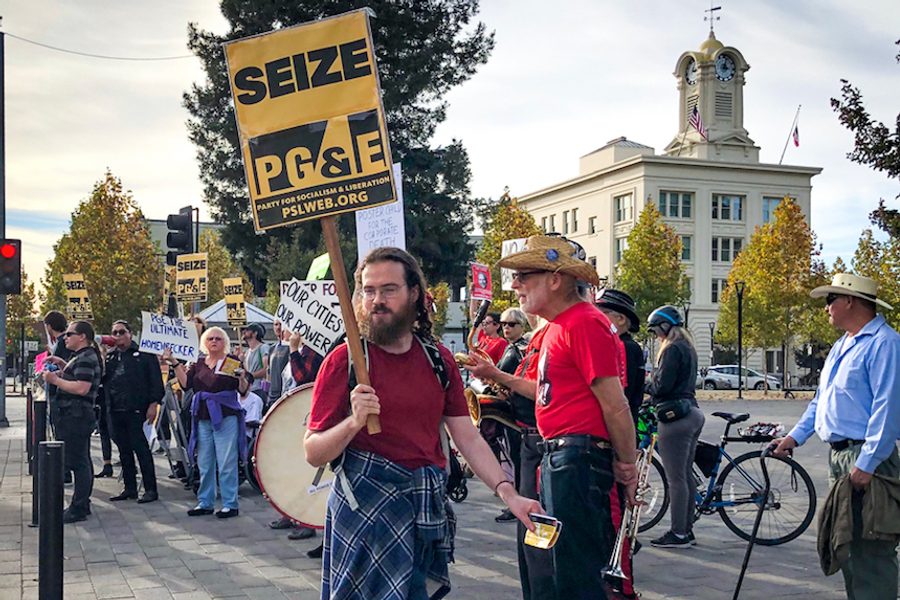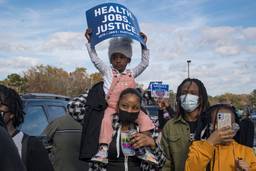“Our Biggest Enemy Is PG&E”: Inside the Fight to Put Utilities Under Public Control
Evacuees of the Kincade Fire and members of the Democratic Socialists of America are demanding PG&E be dismantled.
Nuala Bishari

SANTA ROSA, Calif. — “We’ve been evacuated twice in the past five years,” J.D. Opperman tells a small crowd of around 30 who had gathered to protest Pacific Gas and Electric Company (PG&E) in downtown Santa Rosa on Nov. 16, 2019. Among the protesters were members of the Marin, North Bay and East Bay chapters of the Democratic Socialists of America (DSA). They held handmade signs reading “PG&E: The ultimate homewrecker” and “PG&E: Poster child for the corporate death penalty.”
Opperman explained the first time he was evacuated, during the Tubbs Fire that hit Santa Rosa in 2017, it was “terribly frightening. I had to pack everything I owned, shove it into my car. I was in school, a student, worried about exams and everyday things. I have a child.”
After the fire, Opperman sought cheap rent in Guerneville, a small town in the redwoods on the edge of the Russian River. It’s not surrounded by a tinder box of dry fields like Santa Rosa, but when the Kincade Fire broke out in October 2019, Opperman was again forced to evacuate.
“This time around was even more frightening,” he told the crowd as it stood solemnly in Old Courthouse Square. “The fire forced the evacuation of my two 80-year-old grandparents, one of whom ended up in the hospital for a stomach ulcer from the stress. My family and I called around but every hotel was booked, we had nowhere to go. My girlfriend had a panic attack about money; our businesses [were] closed and we [couldn’t] earn the money we needed to survive. My daughter had a panic attack as well. She was overwhelmed by the situation.”
Opperman was just one of the attendees who personally experienced the stress of last-minute evacuations — from Santa Rosa, Guerneville and Windsor. But the protest wasn’t just for people to share trauma; there was a strong call to disband PG&E, particularly from local democratic socialists.
“We are here today to voice our collective outrage” against PG&E’s corporate interests, says Brandi Chalker of North Bay DSA. “Our biggest enemy is PG&E itself. The losers in this game? That’s us, folks. We stand against PG&E as a corporate, for-profit entity.”
Opperman’s family members were just a few of the nearly 200,000 people forced to flee the Kincade Fire, which burned more than 77,000 acres — making it the largest wildfire ever in Sonoma County. An investigation is ongoing, but it appears to have started from a spark from a broken cable on a high transmission power line. It’s not the first time the utility has been blamed for a blaze, including the Camp Fire in 2018, which killed 85 people in Paradise, Calif.
While climate change and drought have made California particularly vulnerable to fast-moving, powerful fires, the situation has been exacerbated by PG&E’s failure to secure all of its power lines and transformers. Trimming overgrown trees near power lines is a proven preventative measure, but the company has been slow to negotiate with tree-trimming contractors. Of the 2,455 miles of vegetation along power lines identified as high risk, PG&E has only trimmed 760 miles of it. In June 2019, the bankrupt utility announced plans to shell out $11 million in performance bonuses to its executives.
As wildfires have become a seasonal norm, pressure has risen for a public takeover of the shareholder-owned PG&E, mirroring calls across the nation for utilities to be placed under public control. Many utility cooperatives do exist: The Delaware Electric Cooperative, for example, was founded in 1936 and serves 101,000 people, and Bluebonnet Electric Cooperative has served 14 Central Texas counties since 1939. In addition to providing customers with added transparency over decisions and finances, co-op utility companies can also provide local economic opportunities.
But 2019 marked a shift in California as homes and businesses continued burning and mass evacuations and power shut-offs hit an unprecedented scale. By early November, PG&E shut off nearly 2.5 million customers, the largest such event in state history, and politicians are paying attention. More than 20 California mayors, led by San Jose Mayor Sam Liccardo (D), signed on to a plan to turn PG&E into a customer-owned cooperative. Pressure is on for Gov. Gavin Newsom (D) to take a stance on what will certainly become a key voter issue.
The exact logistics of a takeover are still unclear. Despite filing for Chapter 11 bankruptcy, PG&E declined to sell in September 2019 after San Francisco officials made a $2.5 billion offer for the city’s electric grid.
Meanwhile, PG&E CEO Bill Johnson says the public should expect rolling blackouts for a decade. Hours after the Santa Rosa protest, news emerged that high winds ensured more power outages on the immediate horizon.
“Public ownership of this utility is a definite necessity,” Opperman told the crowd at the Santa Rosa protest. “There is no reason that something that is so critical to the modern world and the functioning of daily life should be owned by a private industry.”








